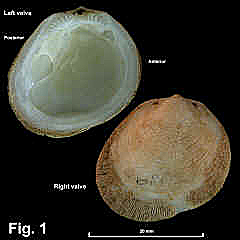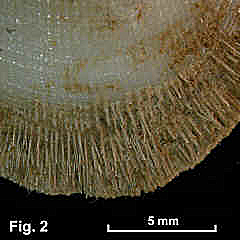|
|
LIMOPSIDAE |
|
|
|
Limopsis tenisoni Tenison-Woods, 1878 Description: Equivalve, inequilateral. Shape obliquely ovate, extended posteriorly; umbones low, slightly in front of midline. Anterior and posterior ends broadly rounded, ventral margin uniformly rounded, byssal notch absent. Hinge curved, teeth strong, number of teeth increasing with shell size, about 10 on each side in mature shells. Ligament small, in a depressed, triangular resilifer. Interior white or pale yellow, microscopically stippled, fine ridges towards margin, posterior muscle scar large and deep, anterior muscle scar smaller. Exterior with coarse concentric ridges, crossed by fine radial threads. Periostracum consisting of needle-shaped elements. Shell colour fawn or white, in life obscured by periostracum (the white spots visible in Fig. 1 were made by some encrusting organism, and are not part of the normal colouration). Size: Up to 34 mm in length. Distribution: Endemic to Australia; Fraser Island, Qld, southwards and around southern Australia to south-western WA, including Tas. Habitat: Subtidal, 73-914 m. Common. Synonymy: Versipella soboles Iredale, 1931 (NEW SYNONYM) is a synonym. When comparing V. soboles with L. tenisoni, Iredale said “[it] is not so oblique, is less cancellate, has fewer teeth”. Comparison of a range of specimens shows it varies a little in shape and cancellate sculpture, and the number of teeth in the hinge varies with maturity, so it fits within the range of variation of L. tenisoni. Senectidens dannevigi Iredale, 1931 is another previously recognised synonym. Limopsis cancella Tenison-Woods, 1877 is also this species, but that name is invalid as it was preoccupied. Fig. 1: Off Port Kembla, NSW, in 82 m (C.68628) Fig. 2: Periostacum of specimen in Fig. 1. |
|

